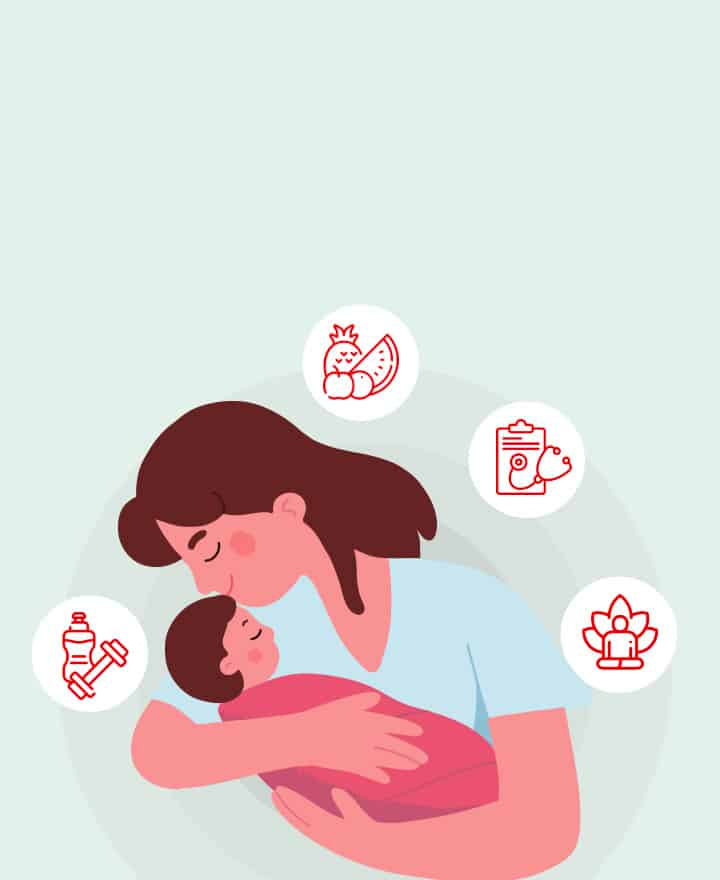
pregnancy is a term that conjures up a wide range of feelings, including excitement, anticipation, and perhaps even a little fear. Subtle changes start to occur as your body sets out on this amazing journey to create life. These changes, sometimes called “signs of pregnancy,” turn into quiet nudges that indicate something amazing is happening inside of you.
While every woman’s experience is unique, some telltale signs of pregnancy might pique your curiosity. This comprehensive guide delves into the fascinating world of these signs, helping you decipher the secret language your body is using to communicate the wonder of new life.
Introduction
The word “pregnancy” is spoken with the same reverence as the deepest secrets of life. Your body starts to transform like a symphony of silent hormones playing a concerto for the creation of a miracle. However, how can you interpret the music? How do you read the cues, the soft prods, that your body is sending out to let you know that something amazing is happening inside?
This engrossing investigation explores the intriguing realm of “signs of pregnancy.” We’ll set out on an exploration voyage, unraveling the code your body employs to convey the wonder developing within you. We’ll unveil the symphony of physical and emotional changes that paint a picture of this remarkable transformation, from the very first whispers to the unmistakable pronouncements.
Envision the excitement of identifying the minute changes – the initial indication of morning sickness, the soft fluttering in your abdomen, the rollercoaster of emotions alternating between excitement and anxiety. With the help of this guide, you can take an active part in this incredible process. Knowing the signs of pregnancy will give you the self-assurance to go through this incredible journey and help you feel connected to the little miracle growing inside of you.
So, dear soon-to-be mother, inhale deeply. Together, let’s go on this exploration. We’ll reveal the symphony of indicators, from the smallest murmurs to the loudest cries, turning pregnancy from an unknown period into a joyous occasion to celebrate the amazing miracle growing inside of you.
Early Signs of Pregnancy: A Gentle Nudge
Your body may be hinting to you that a little miracle is about to happen even before you miss a period. Here are a few signs of pregnancy early on to be aware of:
- Shift in Basal Body Temperature (BBT): If you have been monitoring your BBT, you may observe a persistent increase in temperature following ovulation, which may be a sign of pregnancy early on.
- Breast Changes: Common signs of pregnancy include breast tenderness, swelling, and tingling. Additionally, your nipples may become darker and more noticeable.
- Fatigue: Feeling excessively fatigued? Pregnancy-related hormonal changes can deplete your energy and make you feel lethargic more often than not.
- Food Aversions and Cravings: Have you ever had a sudden aversion to your favorite coffee or a craving for ice cream and pickles? These sharp changes in smell and taste may be signs of pregnancy.
- Urinating More Frequently: Your bladder experiences pressure from the growing baby, which makes you urinate more frequently, especially at night.
- Light Spotting or Implantation Bleeding: Around the time that their period is usually due, some women experience light spotting or implantation bleeding.
Missed Period: The Big Announcement
The earliest and most noticeable indication of pregnancy is frequently a missed period. It’s crucial to remember, though, that irregular periods can have different reasons. It’s important to get a home pregnancy test done if you have missed your period and think you might be pregnant.
Signs of Pregnancy in the First Trimester: The Wonder Unfolds
Signs of pregnancy become more noticeable as the weeks go by. What to expect in the first trimester is as follows:
- Morning Sickness: This typical symptom is not limited to the mornings; it can happen at any time of day. Hormonal fluctuations are the cause of it, and symptoms can include nausea, vomiting, or both.
- Increased Appetite or Weight Gain: You may notice that you are eating more than usual and healthily gaining weight because your body needs more nutrients to support the developing baby.
- Bloating: Bloating, which resembles what you might feel like before your period, can be caused by hormonal changes and the expanding uterus.
- Mood Swings: Your emotions can be severely disrupted by hormonal changes, which can cause irritability, emotional swings, and even tears.
- Changes in Skin: Because of the increased blood flow during pregnancy, you may get acne or a glowing “pregnancy glow“.
Signs of Pregnancy in the Second Trimester: Feeling the Flutters
When morning sickness goes away and energy levels rise again, the second trimester frequently brings a sense of relief. During this prime time, keep an eye out for the following signs of pregnancy:
- Fetal Movement: Usually felt between 16 and 20 weeks, this is a magical milestone. When your baby begins to move around, you may feel a fluttering sensation or feel soft kicks.
- Fast Growth: During this trimester, your baby is growing quickly, which could make your belly appear noticeably larger.
- Linea Nigra: A harmless side effect of hormonal fluctuations is the appearance of a dark line running down your abdomen.
Signs of Pregnancy in the Third Trimester: Nearing the Finish Line
When you get closer to meeting your baby, the third trimester is a time of great anticipation. During this last stage of pregnancy, you should look out for the following signs:
- Increased Braxton-Hicks contractions: These simulated contractions, which are a common prenatal procedure, can feel like a tightening of the abdomen.
- Urinating Frequently: Your bladder experiences increased pressure as your baby grows and descends, which makes you urinate more frequently.
- Breathlessness: As the growing baby takes up more room in your abdomen, you may find it difficult to inhale deeply. Usually, this is harmless and transient.
- Lower Back Pain: You may experience lower back pain due to ligament deterioration and the weight of your baby.
- Nesting Instinct: Do you suddenly need to tidy up, plan, and get your house ready for the new baby? One common instinct is to build a nest.
Beyond Outward Symptoms: The Emotional Excursion of Pregnancy
Being pregnant is a journey, both physically and emotionally. Here are a few emotional indicators that you may encounter:
- Excitement and Anticipation: You may feel a rush of excitement and anticipation for the birth of your child as the reality of becoming a mother sinks in.
- Anxiety and Worry: It’s normal to experience anxiety related to physical changes, childbirth difficulties, and parenthood responsibilities.
- Mood Swings: Your emotions can be greatly impacted by hormonal fluctuations, which can result in mood swings, irritability, and even tears. Never be afraid to ask for help from family members or a therapist if you’re having trouble adjusting.
- Fear of the Unknown: For first-time mothers in particular, becoming pregnant and giving birth can be intimidating experiences. It is quite normal to experience fear. Discuss your worries with your partner, other mothers, and your healthcare provider.
Understanding the Nuances: When to Seek Medical Attention
While the majority of signs of pregnancy are perfectly normal, some may need you to contact your healthcare provider. When to seek medical attention is as follows:
- Severe or ongoing nausea and vomiting: See your doctor if morning sickness is seriously interfering with your day-to-day activities, dehydration, or weight loss.
- Vaginal bleeding: Your doctor should be consulted if you experience any vaginal bleeding while pregnant.
- Severe cramping or pain in the abdomen: While some cramping is normal, severe or ongoing pain may be a sign of an issue.
- Chills or fever: During pregnancy, a fever may indicate an infection that requires immediate medical attention.
- Reduced fetal movement: Get in touch with your doctor right away if you notice a noticeable decrease in fetal movement, particularly in the third trimester.
Accept the Journey: Honoring the Inner Miracle
The period of pregnancy is one of profound change and metamorphosis. You can start this amazing journey with confidence and excitement if you are aware of the physical and emotional signs of pregnancy.
Recall that each woman has a distinct experience. Please do not hesitate to discuss any concerns you may have with your healthcare provider. Pay attention to your body, acknowledge the changes, and accept the miracle that is taking place inside of you.
Conclusion
There’s a culmination of awe and anticipation as the pregnancy symphony crescendos its final notes. Your symptoms, which included the emotional rollercoaster, mild flutters, and morning sickness hints, were all essential to this amazing composition.
You’ve taken an active role in the wonder of life by recognizing these signs. You’ve developed a bond with your child, turning fears into well-informed assurance. Now that you know this, you can welcome motherhood with open arms as you get ready to meet your child.
Recall that the music is not over yet. These indicators will help you and your child’s bond to grow and get stronger. Throughout your journey together, the joys and challenges of parenthood will create a unique composition and a beautiful new melody. Thus, cling to the wonder you’ve encountered throughout this amazing pregnancy. Accept the changes, the feelings, and the close bond you have developed with your child. With the knowledge and confidence you’ve acquired, you are beautifully prepared to step into the role of motherhood and create a symphony of love, laughter, and lifelong memories with your precious miracle.


















